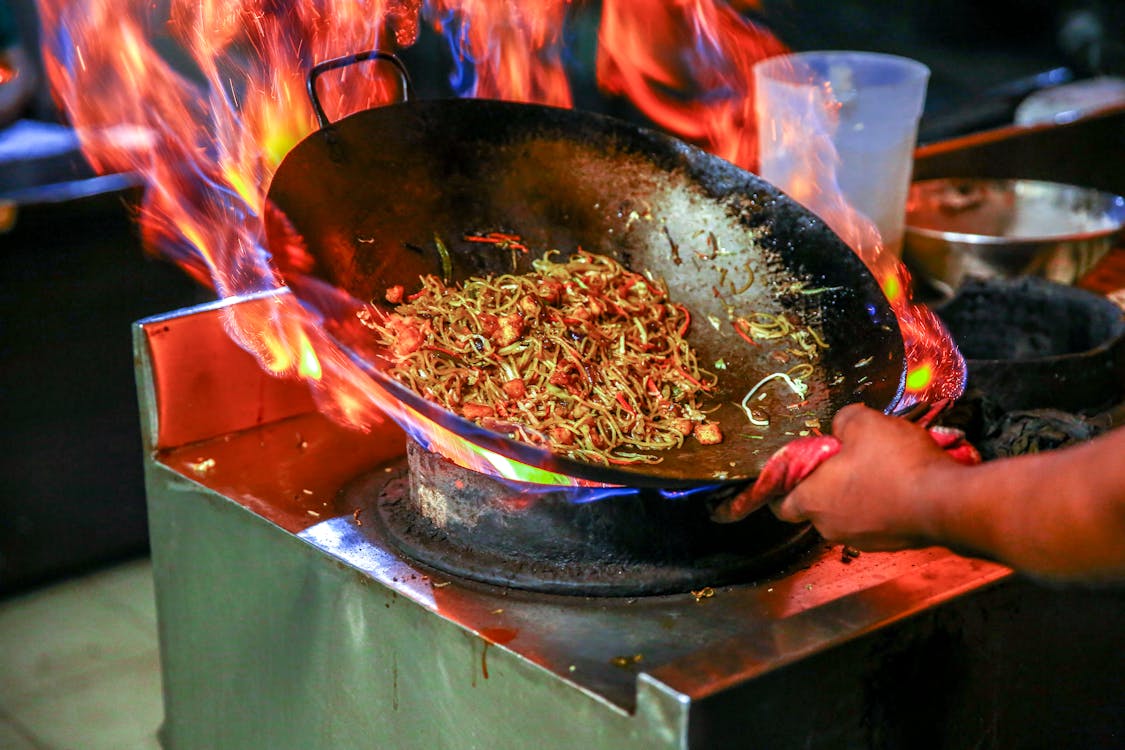Table of Contents
Nasi Goreng
The most beloved dish in all of Indonesian cookery is made by frying chicken strips, glazed with ketjap manis (a syrupy brother of soy sauce). In addition to spring onions, the chicken is mixed with stir-fried rice, like a biriani. This is typically served with a fried egg on top. Simple to make, nasi goreng blends the sweetness of the ketjap manis with the subtle spiciness of southeast Asian dried chilies, for a dish as addictive as it is mouth-watering.
Beef Rendang
In a 2011 CNN article, Malaysian beef rendang was crowned the number one most delicious food in the world. This is accurate. Cubes of chuck steak are slow-cooked with coconut milk and galangal paste in a Dutch oven, for three hours. The result is meat so tender that it falls apart in your mouth. The coconut milk splits, thickening and caramelizing around the beef. The remaining oil is furnished with a scarlet hue and a concentration of all the dish’s notes, soaked-up by the accompanying jasmine rice. Once tried, beef rendang is guaranteed to become your new favorite food.
Lemon Chicken
The crown jewel of Chinese cookery is without a doubt lemon chicken. A favorite among western restaurant-goers and Chinese natives alike, the succulent sweetness and crispiness of this fare is mind-blowing. Butterflied chicken breasts are fried before being blanketed in a sweet and sour lemon sauce, served on top of rice. It’s no surprise that a dish this exceptional is one of the most popular Chinese take-out orders.
As Chinese food can be smoky to prepare – stir-fried in a wok at high-heats, it’s important to use an extractor to purify your kitchen. Extractors can be accented with beautiful range hoods, which endow an essential function with style and elegance.
Massaman Curry
What bestows this Thai dish its memorable fragrance is the use of the Christmas-smelling spice: star anise. This is roasted solo, the pan inheriting these flavors to gift to the meat. Long strips of steak and onions are slowly advanced, before a massaman curry paste (available from Asian supermarkets) is stirred-in with coconut milk and water. The next addition is quartered boiled potatoes, with the option for cashew nuts and tenderized bell pepper slices too. Though some might not expect potatoes in a Thai dish, it can’t be made without them. They absorb the essence of the nutty, satsuma-colored sauce, and pair surprisingly perfectly with rice.
Anglo-Indian Meatball Curry
During Britain’s colonization of India, British soldiers would often start families with Indian women. This spawned a unique ethnicity called the Anglo-Indians. Notable Anglo-Indians include: Frankenstein actor Boris Karloff and stand-up comedians Russell Peters and Billy Connolly. To this day, in cities like Lucknow, the Anglo-Indians maintain their own distinctive culture and gastronomy, which borrows elements from both countries.
When the British arrived in India, they found much of the food too spicy for their European palate. They requested that Indian chefs make something that was both reminiscent of home, as well as being tasty and mild. This resulted in dishes like kedgeree and meatball curry. The latter is made by frying lamb meatballs, before simmering them in a sauce of coconut milk and gentle spices. It’s not a dish you’ll find in many Indian restaurants, but one so tender and delectable, it must be sampled.
Kottu Roti and Egg Hoppers
Walking down a street in Sri Lanka, you’ll hear the machine gun-like rattle of street food chefs with paddle knives, cutting-up kottu roti at superhuman speed as it fries. Curry-powdered chicken, eggs and vegetables are stir-fried, shredded as the dish matures. These are served in ‘egg hoppers’ – thin, latticed baskets of egg, hardened in a saucepan. With this marriage, you’ll sample the true taste of Sri Lanka, through the aromatic infusion of ginger and curry leaves.
Korean Fried Chicken
Most Americans are already familiar with the sumptuous treasure that is Korean barbecue. Most are in agreement that the pride of this region’s cuisine is its sweet and spicy fried chicken. Making this dish couldn’t be easier. In the form of either wings or bitesized pieces, the chicken is dusted in a mixture of cornstarch, baking soda and plain flour, battered with a few drops of water. After the meat’s been shallow-fried at a medium-high heat, it’s drained of oil on a paper towel. The remaining oil is removed from the pan and the cooked meat is put back on the heat with the sauce.
The best sauce is a mixture of gochujang (Korean chili paste), sweet chili sauce, miso paste and runny honey. The sauce quickly reduces and becomes sticky, then is immediately served on a bed of rice. It should be garnished with sesame seeds and sliced spring onions. The outstanding outcome is a fan-favorite. It balances the deep, smoky piquancy of the chili with the candy-like sweetness of the honey. It is so quick and easy to make, Korean fried chicken can comfortably be deployed for any occasion.



/__opt__aboutcom__coeus__resources__content_migration__serious_eats__seriouseats.com__2019__06__20190524-pistachio-paste-vicky-wasik-8-1500x1125-f8bf41daed554eb2934a7b250dd2bc1e.jpg)